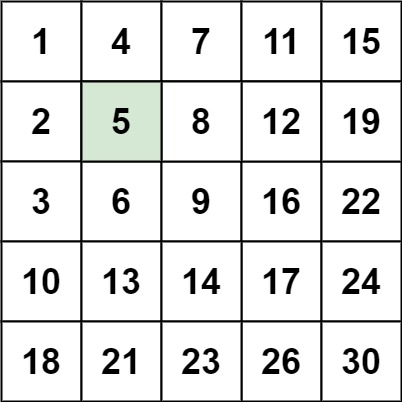Write an efficient algorithm that searches for a value target in an m x n integer matrix matrix. This matrix has the following properties:
Integers in each row are sorted in ascending from left to right.
Integers in each column are sorted in ascending from top to bottom.
Example 1:

Input: matrix = [[1,4,7,11,15],[2,5,8,12,19],[3,6,9,16,22],[10,13,14,17,24],[18,21,23,26,30]], target = 5
Output: true
Example 2:
[外链图片转存失败,源站可能有防盗链机制,建议将图片保存下来直接上传(img-sHEyRiDc-1651025730748)(https://assets.leetcode.com/uploads/2020/11/24/searchgrid.jpg)]
Input: matrix = [[1,4,7,11,15],[2,5,8,12,19],[3,6,9,16,22],[10,13,14,17,24],[18,21,23,26,30]], target = 20
Output: false
Constraints:
m == matrix.length
n == matrix[i].length
1 <= n, m <= 300
-109 <= matrix[i][j] <= 109
All the integers in each row are sorted in ascending order.
All the integers in each column are sorted in ascending order.
-109 <= target <= 109
从最右上角的元素开始,如果目标值小于当前值则可以排除当前列, 因为列是递增的, 如果目标值大于当前值则可以排除当前行, 因为行也是递增的, 这样循环查找, 直到找到目标值或者行和列的 index 超出矩阵范围
impl Solution {
pub fn search_matrix(matrix: Vec<Vec<i32>>, target: i32) -> bool {
let mut row = 0 as i32;
let mut col = matrix[0].len() as i32 - 1;
while row < matrix.len() as i32 && col >= 0 {
let val = matrix[row as usize][col as usize];
if val == target {
return true;
}
if val > target {
col -= 1;
}
if val < target {
row += 1;
}
}
false
}
}







 本文介绍了一种高效的算法,用于在给定的有序矩阵中查找特定目标值。通过利用行和列的递增特性,从右上角开始缩小搜索范围,直至找到目标或搜索边界。适用于解决LeetCode中的搜索网格问题。
本文介绍了一种高效的算法,用于在给定的有序矩阵中查找特定目标值。通过利用行和列的递增特性,从右上角开始缩小搜索范围,直至找到目标或搜索边界。适用于解决LeetCode中的搜索网格问题。
















 399
399

 被折叠的 条评论
为什么被折叠?
被折叠的 条评论
为什么被折叠?








